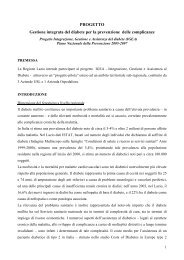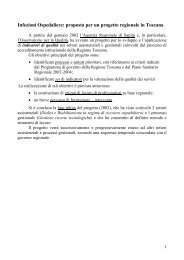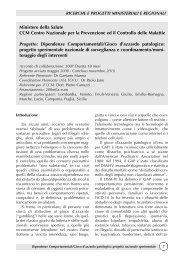Gaining health : analysis of policy development in European ...
Gaining health : analysis of policy development in European ...
Gaining health : analysis of policy development in European ...
You also want an ePaper? Increase the reach of your titles
YUMPU automatically turns print PDFs into web optimized ePapers that Google loves.
Chapter 5<br />
242<br />
way through the implementation process. Considerable efforts<br />
were made by expert groups and task forces, and the<br />
results were published <strong>in</strong> detailed <strong>in</strong>terim reports. Reports<br />
on the results <strong>of</strong> the monitor<strong>in</strong>g and valuation process then<br />
become a valuable resource for future <strong>policy</strong> revision.<br />
There is a general lack <strong>of</strong> <strong>policy</strong> <strong>analysis</strong> to help <strong>in</strong>form the<br />
<strong>policy</strong> <strong>development</strong> process. One exception is Sweden,<br />
where it has been decided that there should be a regular<br />
and systemic review <strong>of</strong> the fulfilment <strong>of</strong> the objectives <strong>of</strong> its<br />
public <strong>health</strong> <strong>policy</strong> (26).<br />
Difficulties encountered<br />
There are <strong>in</strong>herent difficulties <strong>in</strong> monitor<strong>in</strong>g and evaluat<strong>in</strong>g<br />
the type <strong>of</strong> broad policies necessary to promote <strong>health</strong>,<br />
prevent disease and meet the needs <strong>of</strong> those suffer<strong>in</strong>g<br />
from NCD. As seen above, such policies attempt to br<strong>in</strong>g<br />
about changes <strong>in</strong> social structures by <strong>in</strong>fluenc<strong>in</strong>g the social<br />
and economic determ<strong>in</strong>ants <strong>of</strong> <strong>health</strong>, changes <strong>in</strong> lifestyles<br />
and behaviour, changes <strong>in</strong> access to <strong>health</strong> care and other<br />
services, and changes <strong>in</strong> the way <strong>in</strong> which such services perform<br />
<strong>in</strong> the areas <strong>of</strong> <strong>health</strong> promotion, disease prevention,<br />
treatment and rehabilitation. It is difficult to disentangle<br />
the positive and negative impacts <strong>of</strong> such broad policies,<br />
and there is as yet no widely recognized scientific tool<br />
for dist<strong>in</strong>guish<strong>in</strong>g the impact <strong>of</strong> one or other programme<br />
element <strong>in</strong> an implementation process. It is also difficult to<br />
disentangle the impact <strong>of</strong> general socioeconomic changes<br />
that would have happened anyway from those targeted by<br />
NCD policies.<br />
Particularly <strong>in</strong> the case <strong>of</strong> the <strong>in</strong>tersectoral policies necessary<br />
to combat NCD, it is important that the <strong>policy</strong> document<br />
itself def<strong>in</strong>es how monitor<strong>in</strong>g and evaluation are to be<br />
carried out, who will do it and how they will report back,<br />
and what resources will be made available,.<br />
As has been stated elsewhere (27):<br />
Health promotion action requires multiple approaches, relies<br />
on <strong>in</strong>terdiscipl<strong>in</strong>ary <strong>in</strong>puts and operates at several levels over<br />
long periods <strong>of</strong> time. Despite this complexity, <strong>health</strong> promotion<br />
programmes are <strong>of</strong>ten forced to be evaluated with methods and<br />
approaches that, although quite acceptable with<strong>in</strong> medical care<br />
and prevention, are totally unsuitable for this field.<br />
It is clear that <strong>in</strong> this complex field, multiple methods <strong>of</strong><br />
evaluation are necessary, <strong>in</strong>volv<strong>in</strong>g various partners and us<strong>in</strong>g<br />
both process and outcome <strong>in</strong>formation. It has been suggested<br />
that a m<strong>in</strong>imum <strong>of</strong> 10% <strong>of</strong> the total f<strong>in</strong>ancial resources<br />
for a <strong>health</strong> promotion <strong>in</strong>itiative should be allocated for its<br />
evaluation (27). Hungary tried to implement the 10% formula<br />
but this was cut as soon as there was a budget crisis.<br />
It has been suggested (28) that certa<strong>in</strong> areas <strong>in</strong> the evaluation<br />
<strong>of</strong> policies, such as those with which we are concerned,<br />
particularly need attention.<br />
• A clearer def<strong>in</strong>ition <strong>of</strong> objectives and targets, whether<br />
related to outcomes or to processes, would avoid<br />
<strong>in</strong>appropriate expectations concern<strong>in</strong>g evaluation and<br />
accountability.<br />
• This requires more systematic use and <strong>development</strong> <strong>of</strong><br />
reliable <strong>in</strong>dicators <strong>of</strong> progress.<br />
• An appropriate level <strong>of</strong> <strong>in</strong>tensity <strong>in</strong> monitor<strong>in</strong>g and<br />
evaluat<strong>in</strong>g should be adopted, modest attention be<strong>in</strong>g<br />
paid to monitor<strong>in</strong>g tried and tested <strong>in</strong>terventions and<br />
closer scrut<strong>in</strong>y given to newer, <strong>in</strong>novative or potentially<br />
costly <strong>in</strong>terventions.<br />
• Appropriate methods <strong>of</strong> evaluation should be designed.<br />
Certa<strong>in</strong> experimental methods, <strong>in</strong>clud<strong>in</strong>g randomized<br />
controlled trials, are simply not appropriate for evaluat<strong>in</strong>g<br />
complex policies. The advantages <strong>of</strong> different research<br />
methodologies, both quantitative and qualitative,<br />
<strong>in</strong>clud<strong>in</strong>g a wide range <strong>of</strong> data and <strong>in</strong>formation, need to<br />
be comb<strong>in</strong>ed <strong>in</strong> an approach that allows the issues to be<br />
seen from the po<strong>in</strong>t <strong>of</strong> view <strong>of</strong> different discipl<strong>in</strong>es.<br />
Reflections on experiences

















